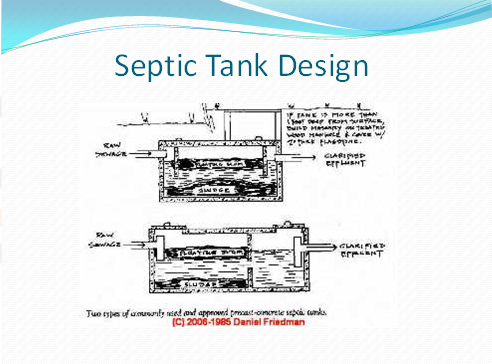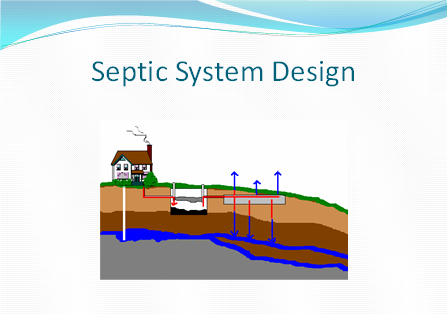SEPTIC TANK BAFFLES - Inspecting the Condition of Septic Tank Baffles
If at the septic tank outlet the baffles are damaged or missing, or if no replacement “tee” has been installed, you can be sure that sewage has been pushed into the drainfield or absorption system, reducing its future life by speeding soil clogging there.
Concrete Septic Tank Baffle Inspection
The condition of the septic tank baffles tells you what has been happening in the septic system. Concrete septic tank baffles may erode from chemicals, detergents, poor concrete mix, water flowing over top of baffles, or may be broken by improper pumping procedures. Look for evidence that the floating scum layer is over or has ever been over the tank baffles - an indication of system failure that needs further investigation.
Septic System Ongoing Maintenance
If you live in a rural area you probably have a septic system instead of a sewer connection. Taking care of your septic system isn’t difficult, because modern systems function efficiently when you follow a few basic guidelines.
Put these tips to use for a clean and trouble-free septic system.
Divert Rainwater From the Septic Drainfield
• A soggy drainfield won’t absorb and neutralize liquid waste. Plan landscaping, roof gutters and foundation drains so that excess water is diverted away from the septic drainfield.
Don’t Overload the Septic Tank and Drainfield
• Check faucets and toilets for leaks; make repairs if necessary.
• Use aerators on faucets and flow reducer nozzles on showers to help lower water consumption.
• Reduce water levels for small loads of laundry.
• Wait until the dishwasher is full to run it.
• Use a displacer to reduce the amount of water needed to flush the toilet.
Keep Trees Away from the Septic System
• Discourage root damage by keeping trees at least 100 feet away from the septic system.
• Trees with very aggressive roots, such as willows, should be even farther away from the system.
The Toilet Isn’t a Garbage Disposal
• Never flush cat litter, disposable diapers, sanitary napkins, tampons, paper towels, facial tissues, coffee grounds, or cigarette butts and filters. They’ll clog your septic tank in less time than you might imagine.
• Do not use ‘soft’ toilet tissues. They decompose very poorly.
Use Garbage Disposals Wisely
• A garbage disposal can double the amount of solids added to a septic tank. It is best not to use one.
• Choose a top-line disposal that grinds food into tiny particles that are easier for a system to digest.
Minimize Heavy Duty Cleaners
• Overuse of heavy cleaners kills beneficial bacteria in the septic tank, so solids won’t break down as well.
• It is best to use liquid cleaners in dishwashers and laundry. Dissolved powders eventually precipitate out of the water.
Do Not Pour Grease Down the Drain
• Grease can clog the septic drainfield, making it impossible for soil to absorb liquids. If that happens you’ll need a new drainfield.
Avoid Hazardous Chemicals
• Varnish, paint thinners, motor oils, gasoline and other similar chemicals can ruin your system and are a hazard to groundwater. Dispose of them properly.
Protect the System from Damage
• Do not drive over the drainfield, build a structure on top of it, or cover it with concrete or asphalt.
• Do plant grass on the drainfield to minimize soil erosion.
Perform Regular Maintenance
• Solids must eventually be pumped from the tank. Many experts advise a family of four with a 1,000 gallon septic tank to have the tank pumped after 3-5 years of full time use. Other experts say you can go much longer between pumping operations.
• Never attempt to open a septic tank yourself. Gases and bacteria in it are dangerous.


Updating a septic system
Over time, and with many varied conditions of age and deterioration of performance, a system can begin to fail to percolate effluent into the ground. This is typically due to the grounds’ inability to absorb more water, due to its porousness becoming clogged with excess solids, greases, etc. being allowed to enter the absorption field.
In this case, an update to the system becomes necessary. This requires a secondary ‘clear effluent’ tank to be installed to allow the septic tank effluent to travel to this tank and a lift pump be installed in the secondary tank to lift the effluent to an absorption field that is now at a higher elevation. This is due to most older (before the mid 1980’s) septic systems are installed with the absorption field being 4 feet deep in the ground. Today’s design standards outline the absorption field to be only 2 feet deep to take advantage of percolation as well as evaporation of the effluent. This is why newer systems can be seen as having green grass growth over the lateral ditch lines.
The original septic tank is still used, if it is in suitable condition, for the digestion of the sewage system. Therefore, all of the comments in this document still apply for the upkeep of the system. The lift pump in the secondary tank becomes an additional item of maintenance. This pump would typically be very reliable and would be equipped with a high level alarm in the tank to indicate its failure.
For more information on septic systems
The National Small Flows Clearing House of the National Environmental Services Center at West
Virginia University offers three brochures in print and on-line on septic system operation and maintenance.
Call 800-624-8301 or 304-293-4191 or go to http://www.nesc.wvu.edu/nsfc/nsfc_septicnews.htm
A good government website is www.epa.gov/owm/water-efficiency.

